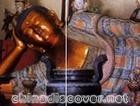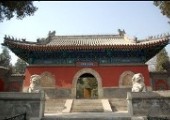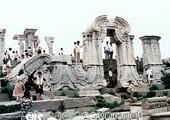Beijing Wofo Temple (Wofosi)
The Temple of the Reclining Buddha is located in the Western Hills at the southern foot of Jubao (also called Shou' an) Mountain, about 20 kilometers from Beijing proper. The rear of the temple is set against the mountain cliffs; at its front are open fields.
 The temple was first built during the Zhenguan period (627-249) of the Tang Dynasty, when it was also known as the Temple of Peaceful Longevity (Shou' ansi). In later periods it fell into ruin and was rebuilt and renamed several times. One of the last major renovations was completed in 1724.
The temple was first built during the Zhenguan period (627-249) of the Tang Dynasty, when it was also known as the Temple of Peaceful Longevity (Shou' ansi). In later periods it fell into ruin and was rebuilt and renamed several times. One of the last major renovations was completed in 1724.
As early as the Tang Dynasty, the temple contained a sandalwood sculpture of the reclining Buddha. In 1330-1331 during the Yuan Dynasty, a large-scale bronze image of the Buddha attaining Nirvana was cast, and from that time on, the temple was popularly called the Temple of the Reclining Buddha. According to the history of the Yuan Dynasty, the casting of this Buddha required 250,000 kilograms of bronze and 7,000 laborers. At the main entrance of the temple stands a glazed tile ornamental archway, and inside there do a bell tower and a drum tower flank a semi-circular pool.
The temple compound is built on an enormous scale. Covered galleries and auxiliary halls to create a completely enclosed series of courtyards link four large halls aligned along the central axis.
The first structure, the shanmen , serves as the main gate. The second large building is the Devaraja Hall (Hall of the Heavenly Kings) and the third is the Hall of the Buddhas of the three Worlds. In traditional temples, this would be the largest hall in the compound, but because the fourth hall contains the image of the Reclining Buddha, the situation here is reversed. The famous bronze Buddha is more than five meters long. It lies in a sleeping position, with one arm extended and the other propping up its head, and is surrounded by 12 smaller Buddhas. According to legend, this scene represents the Buddha on his deathbed giving instructions to his 12 disciples, who are seated under a pair of sal ( poluo ) trees, which bloom in late spring or early summer. At very rear of the temple is a sutra repository built against a cliff. On the western side are rockeries, pavilions and mountain vegetation; all contribute to the beauty of the garden-like setting.




